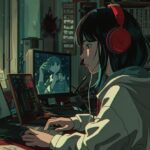We see Siri immediately upon entering, the three of us chatting up a storm like old friends, even though, up until now, I’ve only met her once on Skype to conduct the interview on which this two-part story is partially based. Siri is the type of artist who, to meet, is not just a pleasure but a relief. We can all be our authentic selves today, her sincere appreciation of our arrival indicates.With no shortage of energy, she’s happy to launch into anything, and I see Maja light up in the presence of someone who can match her. The photographer is especially happy today because it turns out LACMA has acquired a piece from the show, something any artist would want, and a real validation of the work on view here.Looking closely at the work in the exhibition, there is an almost insidious presence of arms, tentacles, branches, things which hold or embrace, but seem equally capable of breaking or squeezing. It’s Maja who is especially taken by this, and we put the observation to the test. The bizarrely red octopus on the boat, possibly the most immediately impactful image of them all, human hands holding its tentacles as they lift it aboard the boat. Around the room, a girl in a yellow t-shirt arms outstretched, hanging from low branches, themselves seeming as alive as the octopus arms. A man (Siri’s brother) holding his cell phone above the water in an outdoor hot tub, both the reflection of his arm in the water and his leg just beneath the surface on which his elbow is propped, appear all to fan out like a marriage of ancient Greek and Hindu iconography.
Although the press release explains that “Crow’s Field” is a piece of land Siri and her friends named themselves as kids–land she grew up on with her family in rural New England–it doesn’t mention the circumstances of her life then. It doesn’t mention anything we spent almost three hours discussing on Skype, her life growing up in an American Sikh ashram, or what is called 3HO.She says during our interview, “I do think [the work I’m making] has a lot to do with my upbringing.”
She explains how in Sikhism there were nine gurus. In fact, I later discover, the first was Guru Nanak (1469-1539) who claimed to travel between worlds and through time. This is what is commonly referred to as “astral projection,” a phenomenon described in some form or another the lore of most of the world’s religions. Siri herself acknowledges that the concept is important in Kundalini Yoga and that it was acknowledged, growing up, as a sort of goal one seeks to achieve. Although it would be fair to argue that my observation of the boy in the photograph seemed to me to be passing into another spiritual realm because I had previous knowledge about the artist’s background, I can honestly say, at least in that moment, that astral projection in the Sikh tradition was not consciously in mind. Very likely, it was not consciously on the mind of Siri Kaur either, at the moment the photograph was taken, but one can’t help speculating, as she herself does, about the importance of her religious upbringing in relation to how she sees.
“There were all these fairytales about the gurus,” she says over Skype. “My earliest memory is of a statue of Hanuman, this Hindu monkey god.”
We both laugh at the improbability of this, but, at the same time, it seems to be the hallmark of early memories that they are primal and somehow removed from normal life.
Then she adds, “There’s a lot of crossover between Hinduism and Sikhism.”
Doing my cursory research, I find that this is true, and it doesn’t surprise me, being that religions unavoidably affect each other, and not in a simplistic linear way. There is even a word for the way that cultural and religious traditions combine beliefs, which is “syncretism.”
Because the art world is generally allergic to religion, concepts such as syncretism, important to understanding not only the evolution of religion but of art too, seem absent from the educations that art students receive. Postmodernism, just one example of an abstract grouping of aesthetics and ideas which is taught, could be understood as an engine for syncretic cultural attitudes, as prevalent today as at any time in history. The concept of syncretism, though, is probably fairly well understood within art circles, even if the word isn’t widely known. I suggest that because where, historically, syncretism was a normal practice used to update any one religion’s sacred history for the sake of that religion’s migration and survival, it is today often discussed within the narrower context of appropriation.
Whereas appropriation, I think, implies that imagery is spontaneously generated within a single culture, somehow pure, and performed as is, syncretism implies that imagery is evolved among varied cultural groups over a long period, breathed in or embodied, and necessarily altered with each use. This isn’t a defense of syncretism as a tool for cultural hegemony, but a simple acknowledgement of its inevitability as an artifact of change.
I can’t help but situate Timothy White Eagle’s work in this milieu, perhaps simply because I like the way his performances are likely to confound and challenge the broadest spectrum of those within the art world.
“As an adult,” he explains, “I look back and realize that those [early religious experiences] were authentic, but it was as if I was feeling it with a very limited, stilted vocabulary. Mormonism was all I had to understand Spirit with, and that vocabulary said being gay was wrong, that I was going to hell…I had to let go of all of that…”
Even to listen carefully to his rejection of Mormonism, one hear’s not a wholesale rejection of its authenticity as a vehicle for connecting to the spiritual, but a rejection of its vocabulary to express and include a wider range of experiences.
“I question authenticity all the time because I’m not what some people would call an authentic Indian. I don’t have tribal registration. I was given up for adoption so I was raised by white people. And then only later in life did I start hanging out with indigenous people and working in traditional environments, so I’m sort of in this in-between place. I know very very traditional people, and it’s a different thing than I can offer.”
“When I’m doing my artwork, the field is open. What I’m trying to do is create something new and original that doesn’t appropriate directly, but uses the tools and understanding I’ve learned inside ceremony space, and brings those tools into an environment of performance.”
For Haley Craw, too, one senses the importance of embodiment, ritual, and syncretic vocabulary in her performances and installations, though perhaps with a more direct intention of criticism in mind. Whether on video scrubbing her back with a steak tenderloin to the tune of Evangelical choir music or dangling hardened syrup-covered lingerie from driftwood, she emphasizes the central value of doubt with regard to the mood from which her work originates.
“I’m very interested in inserting this little grain of doubt,” she explains. “And just kind of waiting to see what happens. Because doubt is such a powerful notion, especially when you’re talking about fundamentalism. One little bit of doubt can make all the difference.”
I ramble aloud, as I often do, when I’m doing these Skype interviews, about what I think of as a dynamic relationship between faith and doubt and liberation from ideas which no longer feel true in order to open up to a different way of thinking.
She rescues me from my wandering, as these artists often do and takes hold of the conversation’s direction.
“I’ve really tried not to fix meaning too much. That’s why I’m so interested right now in transformation, because it has this freeing quality The ability to transform is such a freeing thing, because in relation to religious ideology which can express itself in absolutes, I can transform.”
I don’t think of the phrase in the moment, but later, on reflection, I recall Barbara Creed’s phrase the “monstrous feminine,” and find in Haley’s work this sensibility. Perhaps her work functions as a trickster on behalf of, say, the biblical character Lilith or offers a flipped script for Eve, in which their traumas can “spring forth” against dominant control structures.
I share with her my opinion that fundamentalist orthodoxies have a preference for stasis, and so anything that looks as if it’s blooming, morphing, leaking, becoming, or in any way dynamically unfolding, is perceived as a threat to its inherent stasis.
She gets right to the heart of the matter, which is obvious to both of us, and probably to any artist, male or female, who have had to push back against religious fundamentalism in order to be freely expressive. “Massively, these orthodoxies suppress women and women’s sexuality. There’s such an obsession with purity. My strategy is sort of to take these religious myths that are so well known…and theeeen…just kind of…unsettle them. I don’t have one explicit message, but I do want to make it just a little bit uncomfortable.”
She tells a confidential story of how someone close to her responded negatively to the work and what played out as a result. It reminds me of what can be at stake for artists with fundamentalist backgrounds if they break taboos.
Camilla Taylor knows this well, which is why, following an abortion, certainly taboo in Mormonism, she left her community and cut all ties.
“I think a lot of Mormons have a hard time leaving because it’s very community-oriented, in many ways, communistic. They have they’re own welfare system called bishops’ storehouses and stuff like that…but I never felt like I was a member of that community so I didn’t really feel like I was ‘losing’ it when I left. Because I always felt like I was on the outside.”
Nathaniel Evans speaks to this sense of outsiderness even with the very title of his most recent solo show, “This World is Not Our Home.”
“The isolation can feel very very oppressive,” he says. “And when you feel that way, you have to find some way out of that. Whether it’s a personal expression or a political expression…but you have to rebel in some form or fashion.”
Most formerly-religious people I know, artists or not, tend to have what they refer to as their “coming out” stories, a phrase meant half-jokingly and with respect toward those who have truly come out to their families with regard to their sexuality, though, often enough, a young person just might just find himself doing both at once.
It was similar for many of the artists here, including Joel Daniel Phillips.
“My parents really struggled with that. That conversation was one that was very emotional. They still tried to convert me a lot.” He adds with a genuine smile, “I think my mom finally stopped sending me Bibles, like, last year.
She still cites verses all the time or sends notes talking about her own religious experiences. I just can’t relate or interact on that level anymore. I just mostly don’t know how to respond. But it does scare them.”
As he explains, there is hesitation and sensitivity to his delivery, obviously not wanting any pain to come to his parents because of his differences in opinion and belief. The matter is also complicated by the fact that, a number of years ago, they converted from Evangelical Christianity to Eastern Orthodoxy, a truly surprising move I’d never have expected, being that Eastern Orthodoxy is rooted in a less familiar tradition. Evidently, this move has contributed to a deeper acceptance of Joel’s departure. All religions, though, tend to be far more broad in their spectrum of beliefs and attitudes than is known or recognized in the larger world.
In fact, the very question of whether one accepts or rejects a particular religion is an overly simple one, because as Catholics or Jews will often attest, it might well be a matter of how religious you are, rather than an all or nothing proposition. To totally leave a community might not be necessary even where one disagrees with some of its claims or doctrine. And even if one does leave, one is then left possibly to replace it with a community of another sort, which isn’t necessarily an easy thing to do.
Even as Casey Jex Smith intellectually rebelled against Mormon religious practice, he continued to attend church in order to draw the congregation during service, to make what he called his “church drawings,” a longterm series he often updated on Instagram.
“It was an opportunity, in a way,” he explains, “and something I hadn’t seen elsewhere in the art world.”
An issue that Casey and I bonded over, and which I alluded to in part one, was the sense of being an outsider of multiple communities, of being partly involved, but ambivalent at the same time, be it the Mormon Church or the San Francisco art scene, as was Casey’s case. I can’t help but wonder if it’s just organized religion that makes Casey and me anxious or, rather, groupthink in general.
“You’re taking these art theory classes in grad school and you’re thinking, ‘if I want to be a serious artist, I need to be interested in these things, you know? The art world kind of lays out these things that you should be interested in. And it took grad school to be like, ‘oh I’m actually not interested.’ Even though I read that Deleuze article five times, it didn’t mean anything to me. I had to circle back to the things that were naturally interesting to me. And that was weird, biblical narratives, Dungeons & Dragons, and lame fantasy art, even some surrealism. I feel like I’m finally comfortable enough, that if someone says my work is surrealistic, it doesn’t hurt.”
To look at Casey’s colored pencil drawings, my eye races over and through impossible mazes, dead languages, and treacherous pitfalls where, to imagine existing within, would be such a state of confusion as to bring about madness. How does one figure out where one is meant to go, or how things are really operating behind one door or the next? This feeling of bewilderment, of wanting to advance, but always lost, plays out in a game board theater of the absurd, as if Kafka or Bulgakov designed video games. It seems to me the perfect equal-opportunity representation of both organized religion or the art world if one were so inclined to read it that way.
This, it turns out, is not a bad way to read it when considering here is an artist who turned Mitt Romney into a Dungeons & Dragons character and a Book of Mormon story into an entire Dungeons & Dragons campaign.
I remark on how liberating it is to no longer be embarrassed or afraid to make what you want, and, as I say it, I sound as if I’m talking about liberation from religion, even though I’m talking about the art world. I muse at the irony, then wonder if it’s ironic at all, or rather, precisely to be expected. That all social realities are necessarily accompanied by dogma and prohibition, isn’t it precisely the role of artists to transgress if they’re to make anything non-boring at all?
Nathaniel has gone so far as to look to other outsiders to inform his work: “The colors I was using in my palette were from the Weimar period of film, like Fritz Lang… light greens and blues…as well as many of the angles…films like The Cabinet of Dr. Caligari. There was a sense of cultural isolation from the rest of the world as well. I recognized a paranoia that comes from prolonged periods of isolation.”
Neither Nathaniel nor I are the first to see a connection between the German Expressionists and Southern Gothics, the latter no doubt a natural presence in Nathaniel’s Appalachian landscape. To have come up in that environment is not just to conceptualize such a marriage, but to have a visceral predisposition for it.
From the early Puritans to the Pentecostals of Nathaniel’s background, the Evangelicals of Joel’s, or the Mormons of Camilla’s, a monotone or sombre palette, skillful and labor-intensive, seem natural to this way of life even years after breaking away.
In fact, one of the first things anyone will notice about Camilla’s work is that it is always black or some shade of gray. Her sculptures tend to be some combination of animal and human, and even when in multiples, are certainly alone. One imagines them existing in some kind of shadow world, a darkened reflection of this one, quietly, wordlessly going about their business unseen.
Sitting with her at her downtown studio looking around the space, creatures, hands, heads laying or standing here or there, I ask her, “Do you feel, when you’ve made one of these, that you need to take some form of responsibility for them, to take care of them somehow?”
“Yes!” She replies without hesitation. “Absolutely. Almost to a pathological degree. I had this sculpture that was seven feet tall, very frail and spindly, he’s held up by welded steel, but he looks as if he shouldn’t be able to stand up. But he’s easy to knock over. He was at the house and someone kind of leaned over and to feel if he was soft and squishy, and he (the sculpture) started to fall down, and I yelled ‘you’re killing him!’ It was just my visceral response!”
In my own very subjective way, I can imagine her world operating silently parallel to Joel’s, who faithfully depicts those living on the margins, very often in San Francisco. More than once, I’ve recognized someone I’ve seen on the streets in Joel’s drawings. In fact, it was his experience as a teenager and missionary with his church group providing aid and resources to the Tenderloin district’s homeless community that he first met self-named Space Man OT (standing alternately for “Old Testament” and “Old Timer,” depending on the day), a homeless man who since has become a friend and subject of his drawings. This is something Joel takes very seriously.
“I’ve almost quit doing this work several times.”
He’s quiet for long stretches searching for the right words as he explains. “There’s such a fine line between narrative and exploitation…the question keeps rearing its head.”
He hesitates. “At the end of the day…I’m not fixing anything…for them.”
“…but I’m still drawn to making these works…”
“I want to believe that if everyone learned to really see [the homeless], they would want to see them. I believe that they would respond differently, and I believe in the inherent kindness of people…”
“But also, I mean, it’s really for me as much as anyone else, as a process of seeing, and validating someone through the lens of observing…you know…it’s almost a meditative religious act. I’m reminded of a quote by Le Corbusier. ‘The best way to truly understanding something is to draw it.’ I guess that’s what I’m trying to do is find ways to understand someone, and hopefully the viewers see something about who this person is. I think there’s an inherent value to that act of seeing…although…I guess it’s kind of an impossible task. I feel like I’m shouting into the wind sometimes. But that’s how I understand the world around me.”
I ask Nathaniel Evans if faith as a concept has value to him at this point.
“It’s complicated,” he reflects. “When you think about what faith means you sort of have to blind yourself to contrary evidence.”
“Yet this seems necessary as artists somehow.”
“Well, I think it’s a necessary part of being human. I mean, I don’t think religion formed itself in a vacuum and I don’t think it’s disconnected from us now. Being an artist is just another way of being a religious monk of some sort.”
As he says this, we laugh together, perhaps because it feels true even if it seems somehow ridiculous to say aloud. But to reflect even briefly on anything from cave painting to the middle ages to plenty of work being made now, one can’t help but acknowledge how perfectly sensible a claim like that actually is.
“You could argue,” I suggest, “that art and religion were born together.”
“Yes,” he says. “I absolutely agree with that.”
I confess to Nathaniel, in the end, that I feel like a religious artist, even if I don’t take most religious claims to be literal truth or follow a specific one. But haven’t I lied to myself if I don’t first accept the leap to faith I took in going beyond the common limitations of reason and into a way of responding to the world that deepens my experience of being here? And wouldn’t it be a lie too, that the years of experience didn’t prove the value of this discreet form of faith, even when reason hasn’t? What have I been doing over the years if not blindly following a call, and what am I now if not a devoted practitioner of this nameless other faith?
I remember again what Tim said about Mormonism lacking the vocabulary he needed to express a broader spiritual experience that felt more inclusive and authentic to him. Most typical conversations about religion assume that you either believe or you don’t, you are or you aren’t, but I find even this vocabulary to be to be limited in its assumptions about how this whole thing works.
I fully embrace the private utility of my own vocabulary, understanding that the views and thoughts of the other seven artists, for example, are very different from my own, and that mine is not adequate for expressing their truths, nor should it be. It’s not that I think we’re that different, but I do think the minor differences matter profoundly to what our respective work requires of us.
Listening to these interviews over and over again as I have over the past two months, I now hear these artists’ voices in my head as I go about my day. I’ll try to work something out in my mind, wishing I had asked a different question, or laughing at a remark someone made, or disappointed that I can’t relate something someone told me that I think is really important for others to know. I wonder what kind of an impact conversations like this would make within the angry clamor of voices gravitating farther and farther toward the polar extremities of political speech, each extremity less and less comfortable with belief systems different from its own. If artists, whether believers or atheists, can leave their inherited religious backgrounds behind and yet think in complex ways about religion, I wonder why this seems so difficult in the so-called secular realm.
Perhaps the most menacing religions ahead are those too new to be named.









